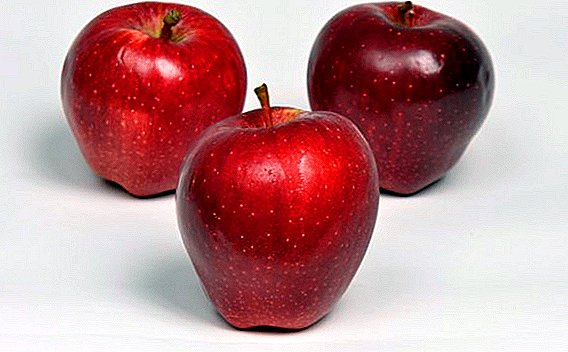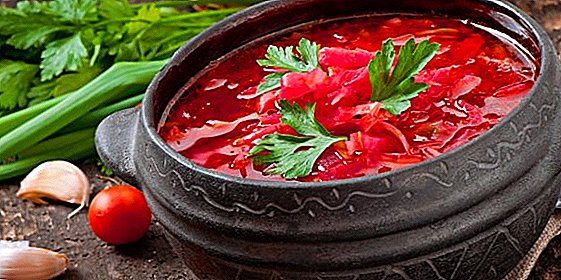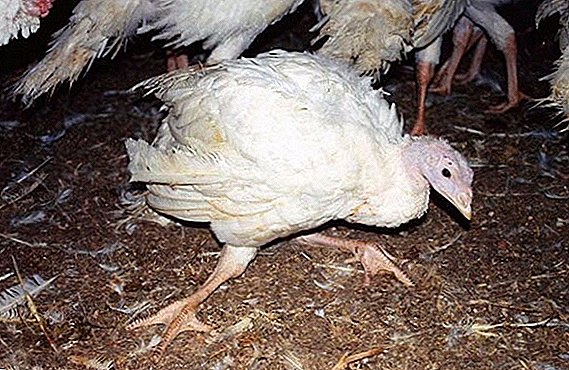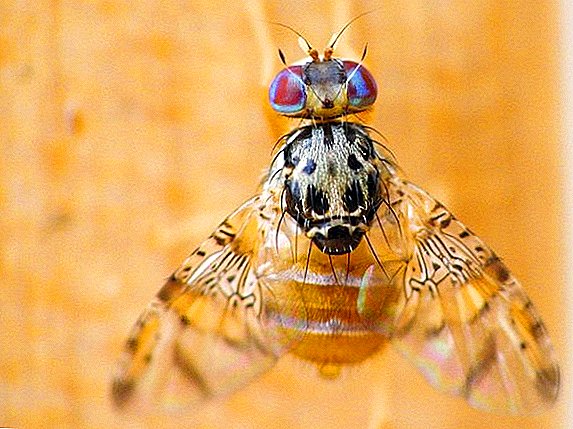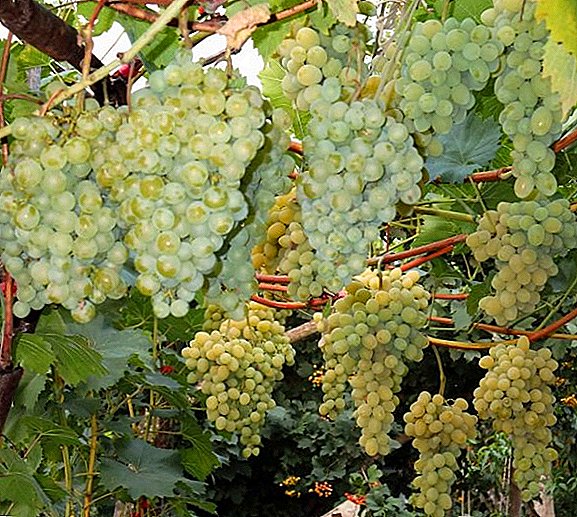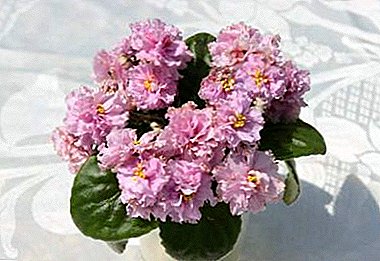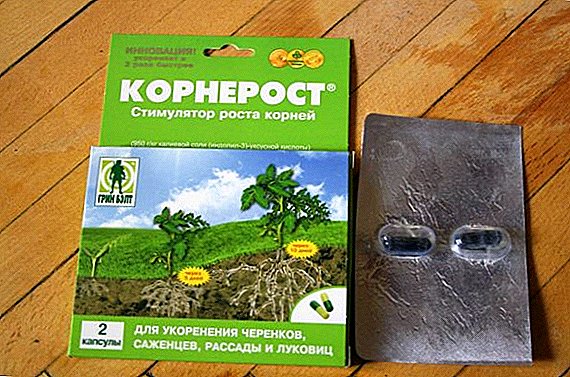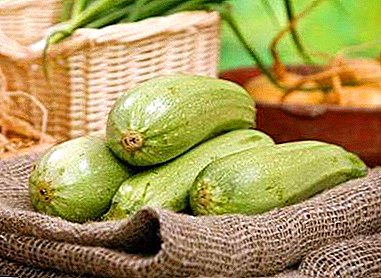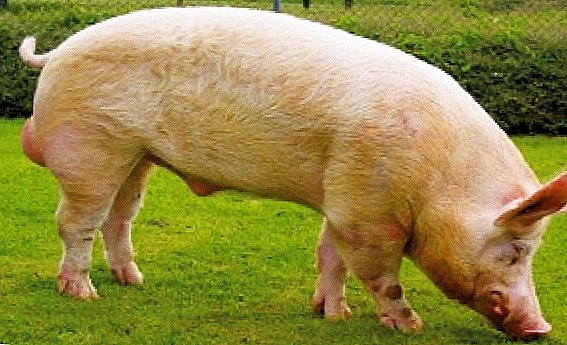 Large white pigs are the most common not only in our country, but throughout the world. It is clear that this breed attracts experienced pig breeders not by its color, but by its performance indicators. Today, these pigs are the most popular in breeding, because they have the ability at the genetic level to retain all of their best qualities.
Large white pigs are the most common not only in our country, but throughout the world. It is clear that this breed attracts experienced pig breeders not by its color, but by its performance indicators. Today, these pigs are the most popular in breeding, because they have the ability at the genetic level to retain all of their best qualities.
Good grease and meat productivity, calm temper and high reproducibility of generations make keeping and breeding these pigs an economically profitable business that attracts even the lazy. To learn more about the features of large white pigs, we offer to read the article below.
Going for the pigs: the rules for choosing healthy individuals
 The most important thing in breeding pigs is to choose healthy and productive piglets, at the expense of the offspring of which you can develop your whole business or simply expand your household. In this case there are several generally accepted rules recommended by experienced breeders:
The most important thing in breeding pigs is to choose healthy and productive piglets, at the expense of the offspring of which you can develop your whole business or simply expand your household. In this case there are several generally accepted rules recommended by experienced breeders:
Pigs are usually sold at the age of 1 month. It is very important that by this time they were able to feed on their own, usually with food from a trough. Otherwise, you will have a lot of problems with acquired animals, even unpleasant lethal consequences are possible.
Therefore, it is worthwhile not only to ask the seller in detail about how and what his piglets feed on, but also to observe the process of food intake as much as possible. It is very good if the animal captures and chews food through the mouth.
If the process of eating looks like a pig sucking, then he has not yet been weaned by the mother and the seller has not yet taught him to self-feed.
It is important for such pigs as a large white and the presence of the correct bite. From this directly will depend on how quickly the animal can gain weight. With incorrectly interlocking jaws, the pig is not able to fully chew food and is forced to swallow its pillars. As a result, the food is not completely digested and simply removed from the body, and not giving the animal its nutrients.
It also causes digestive problems. Therefore, when choosing a piglet, very carefully inspect its teeth and how tightly the upper and lower jaws close together.
The constitution of a piglet's body is the main indicator of its productivity and health. When choosing a large white breed of pigs, pay attention that their backs are straight and their sacrum is even.
 Also, for the described breed is characterized by a large length of the body, which manifests itself at an early age. Piglets' legs must be strong, because as adults these animals gain very large weight, which they cannot carry on weak legs. The head of the representatives of the breed is medium in size with a straight forehead and a patch stretched forward. Ears fall on the crowbar and can close their eyes a little.
Also, for the described breed is characterized by a large length of the body, which manifests itself at an early age. Piglets' legs must be strong, because as adults these animals gain very large weight, which they cannot carry on weak legs. The head of the representatives of the breed is medium in size with a straight forehead and a patch stretched forward. Ears fall on the crowbar and can close their eyes a little.
Experts recommend buying several piglets at once, because in this way they feed better. In general, pigs are considered to be herd animals, therefore they are familiar with a sense of competition in the absorption of food. Thus, even without experiencing hunger, animals will simply try to absorb as much food as possible, which as a result will only benefit their weight.
The argument for growing several individuals at the same time is an expedient decision that the forces spent on caring for one pig and for several will be almost equivalent. But in terms of profit, these are completely different things.
Characteristics and features of the breed of a large white pig
England is the birthplace of this breed, but it has been bred for more than 30 years in the territory of the former USSR. During this time, it has changed significantly. In particular, modern animals are characterized by a stronger body constitution and good adaptive properties.
Due to this, as well as good productivity of meat and fat areas, today among the entire pork herd, the number of representatives of a large white breed is about 80%.
What advantages does the breed boast?
- Ability to adapt to the most diverse climatic conditions. It is for this reason that the large white pig has become so common in Russia, since both the hot climate of Krasnodar and the cold of Siberia are perfect for life for it. Moreover, individuals can be transported from one region to another without any problems, and it will take them only a few weeks, maybe days, to adapt to new conditions.
- Unpretentiousness to a diet. Once again, we note that this breed belongs to the meat-greasy direction, so any type of fattening can be used for it and for any it will give a good result. As food, these animals are ideal and concentrates, and a variety of feed and succulent feed. Large white pigs are also successfully grown on ordinary food waste, which they eat with great pleasure.
- The flexibility of the genetic structure. Due to this advantage, representatives of the breed easily retain all their best characteristics over the years, and even were able to pass them on to other breeds. But It is impossible to consider the genetic code of large white pigs to be rigid: throughout the whole period of the breed’s existence, it was also quite well improved - the constitution and overall productivity improved.
- Excellent performance. The carcass of a large white pig consists of a large amount of meat and fat. The muscles of these animals develop very well and quickly, while the meat remains tender and at a rather mature age. Fatty tissues begin to be deposited from a very early age and, by the time a suitable time for slaughter occurs, accumulate in large quantities.
- An important aspect of productivity is the ability of sows to produce more than 10 piglets at a time. Due to its large size, it feeds and nurses all of them without problems, ensuring good reproducibility of generations.
- Large white pigs are characterized by precocity. That is, individuals ripen very early and already at the age of one year, the sow usually happens to be with a boar for offspring. Some sows with a particularly good maternal instinct contain exclusively for carrying offspring.
Disadvantages of large white pigs: what troubles can be encountered when breeding a breed?
 The main disadvantage is obesity. After all, on the one hand, it is very good that these pigs are capable of absorbing almost any food, but on the other it results in unpleasant consequences. Such animals often suffer from heart diseases, as a result of which their period of life is significantly shortened. Due to the large amount of fatty tissues, the quality of meat deteriorates.
The main disadvantage is obesity. After all, on the one hand, it is very good that these pigs are capable of absorbing almost any food, but on the other it results in unpleasant consequences. Such animals often suffer from heart diseases, as a result of which their period of life is significantly shortened. Due to the large amount of fatty tissues, the quality of meat deteriorates.
Representatives of the breed also have such constitutional features as very soft tanks and a slightly drooping sacrum. In consequence of this, the buildup of tissues on the back of the body can not be called intense.
Also, when keeping a large white pig in the southern climatic zones, it is advisable not to let the animals out into the street under the scorching sun. For walks you need to build special sheds. The fact is that because of the white suit, these pigs can burn very badly, as a result of which their temperature rises for a while, their appetite decreases and, consequently, their weight indicators decrease.
But too low temperatures are not desirable for large white pigs. They have practically no wool, so the animals very quickly lose their heat and begin to freeze.
Features of the exterior and main parameters of a large white breed of pigs
 The breed is characterized by a small and very light head, which has proportional dimensions. The most important feature is a very wide forehead and a small snout.
The breed is characterized by a small and very light head, which has proportional dimensions. The most important feature is a very wide forehead and a small snout.
The profile is very concave, in consequence of which, the nose is almost straight. Their ears are very large and elastic, but not thick. From the head, the ears are slightly raised up and directed slightly to the sides and forward, as if hanging over the animal's muzzle, covering their eyes slightly.
The very body of the pig is quite wide, has the same wide and deep chest. The back is generally flat, but towards the back it is slightly arched, although the transition to the lower back and sacrum is almost imperceptible. All this testifies to the combined type of breed performance - the ability to develop muscles well and accumulate adipose tissue. Also, the body is rather long, which characterizes productive sows that can simultaneously feed more than a dozen piglets.
It is important for any animals to have legs, because on weak legs it is quite problematic to grow a large animal. But in the pigs of large white breed the legs, although short, but strong, correctly set. There are almost no skin folds on the legs. The hooves are very flat, but massive and strong. The latter characteristic allows this breed to be grazed in open space, since it is not too difficult for animals to travel long distances.
The advantage of keeping this breed at home is also connected with the very flexible nature of the animals. They are very responsive to human affection, quickly get used to the owner. Very rarely there are cases when these pigs undermine the floor or break the enclosures. True, it is highly desirable to provide them with a place where they could dig around the earth and swim in the mud. Sows are very caring towards their offspring.
 This breed is not for nothing called a large one, in its size its representatives really achieve great performance. Already at the age of 36 months, the average weight of boar can be 320-350 kilograms. Sows are not so large, but in general I also inspire with my weight - from 220 to 250 kilograms.
This breed is not for nothing called a large one, in its size its representatives really achieve great performance. Already at the age of 36 months, the average weight of boar can be 320-350 kilograms. Sows are not so large, but in general I also inspire with my weight - from 220 to 250 kilograms.
Feed consumption for fattening large white pigs is very low. With an average daily weight gain of 650-700 grams, which pigs usually have between 180-190 days old, an average of 3.9 feed units per kilogram weight gain. At this rate, by the age of six months, boars are already gaining weight in 100 kilograms.
The slaughter yield of carcasses of such pigs is about 82%, which is an unusually high rate even for these animals. The amount of meat usually exceeds the amount of fat, although in individuals suffering from obesity their number may be almost the same.
Features care for large white breeds of pigs
Feeding pigs: the right diet for the right gain
To get meat-greasy products of high quality, animals need to be fed with high-quality and vitamin-rich food. Ideal to combine regular feeding with the help of concentrates and food waste with walking and grazing on succulent herbs. In winter, it is very important to give the pigs finely chopped hay or straw.
Among the main components of the diet of large white pigs should pay special attention to such Products:
- Potatoes (it is better to give boiled, but be sure to drain the water in which it was prepared).
- Carrots, beets, radishes (can be given in small quantities and raw, but first need to grind).
- In good years, you can feed pigs with pears and apples, but in limited quantities, as an additive to the basic diet.
- Dairy products are especially useful to young individuals, although it is also useful to mix them with food for adult animals.
- Succulent feeds such as peas and alfalfa.
- Barley, oats, wheat, rye. It is better to give the grain in ground or even steamed form, since the pigs are not able to chew it fully and as a result it is entirely removed along with the feces.
- Seasonal feed: cabbage leaves, beans, zucchini, pumpkin, corn.
Pigs need to prepare food every day, including boiled root vegetables, vegetable food, milk whey and ground wheat. A piglet needs about 2-3 kilograms of food per day. It is important to give the pigs salt, which will help strengthen the bones.
Small nuances of keeping and growing large white pigs
The best conditions for the maintenance of large white breeds of pigs are warm pigsty with a good ventilation system. If you are going to not only maintain them, but also to breed young offspring, then be sure to organize the lighting. An important requirement for the room are special grooves for the withdrawal of liquid waste products.
Pigsty is important to think in such a way that animals can be released for a walk. The machines should have such an area that the animals themselves require: a sow and a boar need at least 4m2, 3m2 will be enough for the youngsters, but about 6m2 for a sowing sow.
Young pigs and fattening pigs should be fed about 5 times a day. Also, it is worthwhile to additionally put the trough with warm and clear water, especially if the feeding is carried out using concentrates.
Farrowing in sows: do you need human intervention?
Sows are ready for the mating at the age of 6 months, but it is better to let them grow for another two months so that carrying the offspring does not harm the body of the pig. Best of all, if at the time of coverage the sow reaches the age of 10 months and weighs 120 kilograms. Mating is carried out only when the sow itself manifests a hunt: her genitals swell and redden, a small outflow appears, the animal behaves restlessly, loses its appetite.
 Farrow in large white pigs occurs after 115 days from coverage. Red pigs, swollen mammary glands, lowered belly will also indicate the soon appearance of piglets.
Farrow in large white pigs occurs after 115 days from coverage. Red pigs, swollen mammary glands, lowered belly will also indicate the soon appearance of piglets.
A sow washes start to independently make a nest of straw in one of the corners of the corral. A person does not need to interfere in the process of farrowing, although it is worth being near the pig at this time. It is important to immediately take away the piglets and clean the nose, ears and mouth from the mucus. Also, you can immediately cut the umbilical cord and burn it with iodine. After the first 45 minutes of life, you need to feed the piglets, planting them under the sow.
This is not an easy task, because the litter of one pig usually makes 11-12 piglets weighing 1.2 to 1.3 kilograms. Therefore, it is better to do it together, or even three. The maximum farrowing of large white breed sows was 13-15 piglets. Milk for offspring is usually sufficient, since the milkiness of a pig is on average 80 kilograms.



